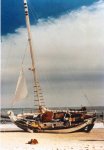Tranona
Well-Known Member
Out of interest, how does that compare with a new built, more traditional, cruiser? An HR or something like that?
About one third of the price. An HR 42 basic would be £700k, a Najad 395 well equipped £600k. New style Bavaria 45, fully loaded (in a Med sunbathing way) £380k




